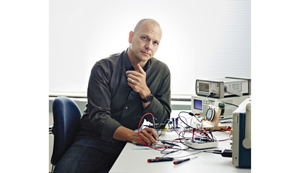
In the late 1990s a young entrepreneur named Tony Fadell tried to persuade Stewart Alsop, a journalist who had recently become a venture capitalist, to invest in his startup, Fuse Systems. Fadell had done a stint at the pioneering mobile-software company General Magic and then created a division within Philips to make handheld devices. Neither General Magic nor the Philips pocket computers amounted to much. But Fadell intended to leverage his experience with a new venture. His pitch was not subtle. Says Alsop: “He essentially said, ‘I’m the guy who knows more about mobile products than anyone else. Give me money.’ ” Alsop declined.
上世纪90年代末,一位名叫托尼o法德尔的年轻企业家试图说服记者出身的风险投资家斯图尔特o艾尔索普投资于自己的新创企业Fuse Systems。法德尔曾在先锋移动软件公司General Magic就职,随后在飞利浦(Philips)创建了一个专做手持设备的部门。General Magic和飞利浦的袖珍电脑产品都未能取得大的成就。不过,法德尔打算利用自身经验开展一项新的事业。法德尔的说辞可不谦虚。艾尔索普说:“法德尔对我说:‘关于移动产品,我懂得比谁都多。给我投资吧。’”艾尔索普拒绝了。
An entire decade passed before Fadell asked VCs for cash again. But what a decade it was. Fadell abandoned Fuse Systems and joined Apple to lead the team that created the iPod. That singular achievement–the iPod rejuvenated Apple and reordered the music industry–transformed him from a struggling startup guy to an accomplished executive who’d withstood the sound and fury of Steve Jobs. Fadell became known around Silicon Valley as the mercurial “godfather” of the iPod, and he added another dazzling line to his résumé by assisting in the development of the iPhone. When he stepped down from Apple’s management team in 2008, there was much speculation about his next move.
此后,整整过了十年,法德尔才再次向风投伸手要钱。他这十年可是没有虚度。法德尔放弃了Fuse Systems项目,加盟苹果并领导团队开发出了iPod。iPod这款产品重振了苹果公司,还颠覆了整个音乐产业。这项成就也使法德尔从一个苦苦奋斗的创业者变成了一位敢于直面史蒂夫o乔布斯的咆哮和怒火的成功高管。硅谷都知道法德尔这位善变的iPod“教父”。之后,他又协助开发了iPhone,给自己的简历又添上了浓墨重彩的一笔。法德尔2008年离开苹果公司管理团队时,对于他的下一步举动,外界曾有种种猜测。
Rather than jump into anything, Fadell took a couple of years off to travel and build a vacation home. The latter experience triggered an epiphany: He hated all of the thermostats he had to choose from for his house, and he decided to design a new, better one, around which he’d build a company called Nest Labs. He hit the fundraising circuit in 2010, and this time the reception was significantly more welcoming. His pitching skills had improved. Randy Komisar, a partner at Kleiner Perkins Caufield & Byers, remembers staring at a black velvet cloth draped over a product. Fadell would remove it only after he’d methodically set up the business case.
法德尔没有马上发力,而是休息了几年,四处旅行,还给自己建了个度假屋。建度假屋的经历给了他灵感:他得给自己的房子选一款恒温调节器,但他对可选的产品都很不满意。法德尔最后决定自己动手设计一款更出色的新品,同时围绕这款产品打造一家叫Nest Labs的公司。他在2010年开始募资,这一次,他明显受待见多了。他的游说能力也得到了很大的提高。风投公司KPCB合伙人兰迪o科米萨记得自己盯着盖在产品上的一块黑天鹅绒。法德尔直到有条不紊地讲完商业案例后,才揭开了这层神秘的面纱。
For Apple cognoscenti, the cloak-over-the-device shtick was an overt homage to Steve Jobs. The late CEO routinely shrouded products, in public demos as well as in his own conference room, in order to build excitement for the big reveal. Yet when Fadell pulled back the veil to display a Styrofoam prototype of a round thermostat, Komisar was crestfallen. “My emotions couldn’t have been lower,” he says. He perked up, however, when he saw Fadell’s last slide: “After the thermostat we plan to do the same thing for every unloved product in the home and make them all magical.” Says Komisar: “Then I got it. Nest was a Trojan horse into the home. In 48 hours we had a check for Tony.”
了解苹果的人都知道,让产品犹抱琵琶半遮面的手法明显是效仿已故苹果前首席执行官史蒂夫o乔布斯。乔布斯不论是在公开展示中,还是在自己的会议室里,一贯喜欢把产品先盖起来,以增加听众对“掀起盖头”的期待和兴奋。然而,当法德尔掀起黑天鹅绒,展示圆形恒温器的泡沫塑料原型机时,科米萨失望不已。他说:“我当时的心情简直跌到了谷底。”不过,当他看到法德尔的最后一张幻灯片时,又振作了起来。这张幻灯片上写着:“在恒温器之后,我们计划将所有不讨喜的家居设备一一改造,化腐朽为神奇。”科米萨说:“我一下子就明白了。Nest就是入侵家居领域的特洛伊木马。于是,我们在48小时内就给托尼开了支票。”













